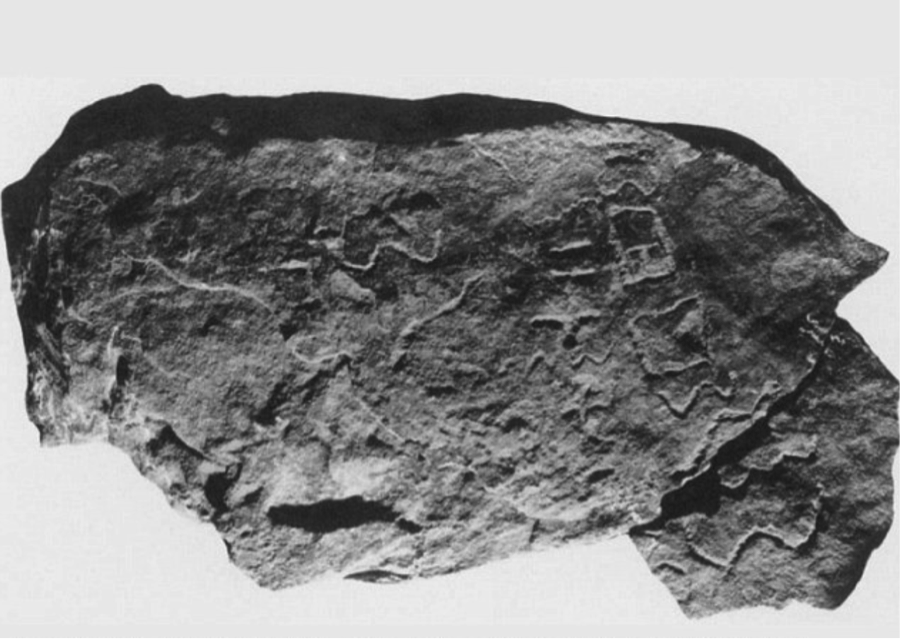Moses is referred to by name in the 15th century B. C. Hebrew inscription Sinai 361 from the Egyptian mines at Serabit el-Kadhim.

The relevant portion of the inscription reads: “Our bound servitude had lingered. At that
time, Moses provoked astonishment.”[2] Dr. Douglas Petrovich, the scholar who translated the inscription, comments:
time, Moses provoked astonishment.”[2] Dr. Douglas Petrovich, the scholar who translated the inscription, comments:
[T]he writer was communicating that the Hebrew people
had endured bound servitude under compulsion . . . several contemporary
Sinaitic inscriptions from the same turquoise mines strongly suggest that
Egyptian authorities were the culprits. . . . This scenario matches well with
the historical narrative of Exodus[.] . . . Moses [is the] only plausible
reading [of the inscription] in this context. . . . The astonishment that Moses
provoked almost certainly followed Moses’ return to Egypt . . . [and] the
plagues reported in the Bible[.] . . . [T]he details of Sinai 361 match those
of Exodus 1-5 remarkably well . . . cogent epigraphical attestation to Moses
dating to the fifteenth century now stands in print[.] . . . [The] biblical
writer called Moses most likely is the individual named on Sinai 361.”[3]
had endured bound servitude under compulsion . . . several contemporary
Sinaitic inscriptions from the same turquoise mines strongly suggest that
Egyptian authorities were the culprits. . . . This scenario matches well with
the historical narrative of Exodus[.] . . . Moses [is the] only plausible
reading [of the inscription] in this context. . . . The astonishment that Moses
provoked almost certainly followed Moses’ return to Egypt . . . [and] the
plagues reported in the Bible[.] . . . [T]he details of Sinai 361 match those
of Exodus 1-5 remarkably well . . . cogent epigraphical attestation to Moses
dating to the fifteenth century now stands in print[.] . . . [The] biblical
writer called Moses most likely is the individual named on Sinai 361.”[3]
Dr. Petrovich's book The World's Oldest Alphabet: Hebrew as the Language of the Proto-Consonantal Script is well worth reading (if you wish to buy a copy, you can save on it by clicking through a portal here). His identification of the proto-consonantal script with Hebrew has provided a number of significant new evidences in favor of the accuracy of the Old Testament or Hebrew Bible, and I am thankful to have been able to utilize Dr. Petrovich's scholarship in my book on archaeology, where the find above is discussed, along with many other powerful historical supports for the accuracy of the Old Testament.
[1] Sinai
361 (Cairo Museum); see Romain F. Butin, “The Protosinaitic Inscriptions,” Harvard Theological Review 25:2 (1932)
plate 19.
361 (Cairo Museum); see Romain F. Butin, “The Protosinaitic Inscriptions,” Harvard Theological Review 25:2 (1932)
plate 19.
[2] Douglas
Petrovich, The World’s Oldest
Alphabet: Hebrew as the Language of the
Proto-Consonantal Script (Jerusalem:
Carta, 2016), 169; cf. 158-172.
Petrovich, The World’s Oldest
Alphabet: Hebrew as the Language of the
Proto-Consonantal Script (Jerusalem:
Carta, 2016), 169; cf. 158-172.
[3] Douglas
Petrovich, The World’s Oldest
Alphabet: Hebrew as the Language of the Proto-Consonantal
Script (Jerusalem: Carta, 2016),
169-172.
Petrovich, The World’s Oldest
Alphabet: Hebrew as the Language of the Proto-Consonantal
Script (Jerusalem: Carta, 2016),
169-172.